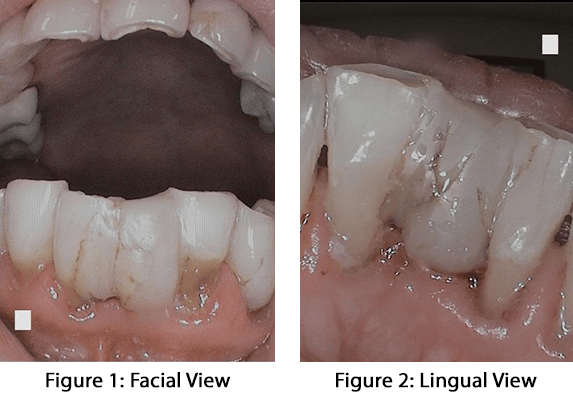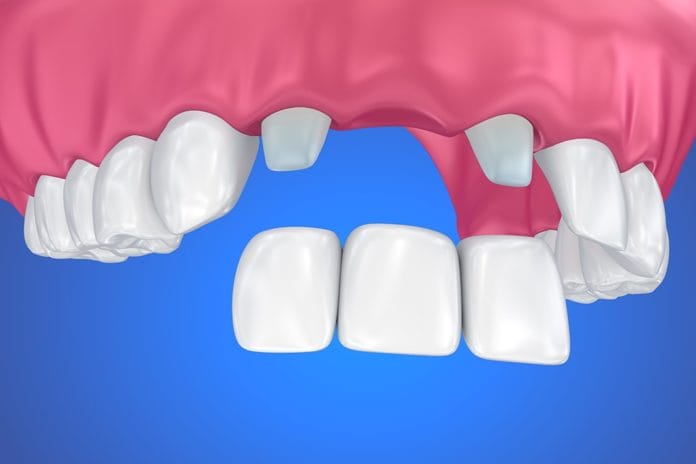A pontic to natural tooth bridge is when an anterior tooth is extracted and then used as the replacement tooth. The compromised tooth may be affected by trauma, periodontal disease, root canal failure, root resorption, or other root problems to where it needs to be extracted. If the crown of the extracted tooth is healthy, it can then be used as the pontic. It’s then bonded to the neighboring abutments.
All of the bonding is on the backside of the teeth, so it’s unnoticeable. The visual side looks pretty close, if not better, than before the extraction. This procedure is used for the front teeth only and can be used on the upper or lower jaw, and it can be a permanent or a temporary treatment.
Although the pontic to natural tooth is not a common procedure, it is beneficial and effective for certain situations.
Benefits
This procedure is a worthy alternative if the adjacent teeth are not compromised, and they do not need a crown. With this type of bridge, the adjacent teeth do not have to be altered or compromised as it does for a standard bridge. With the front teeth being smaller in general, spacing is limited, making an implant possibly less conducive. Or, if an implant is an option, during the healing time for an implant, a pontic to natural tooth bridge is a great esthetic option as opposed to a missing front tooth, flipper, or partial.
The pontic to natural tooth bridge is more comfortable than a partial or flipper. It fits and doesn’t have to be adjusted on a regular basis. Esthetically, this is a great option since the tooth was originally from that site. The shape, contour, and shade adapt well. There is no custom shading that needs to be done to match “as close as possible” to the adjacent teeth.
No lab fees are attached to the procedure, so the cost is less expensive.1 The other perk is that there is not a two-week period in a temporary appliance while waiting for a permanent placement. This procedure is a one-appointment event with instant gratification.
Contraindications
When considering this natural tooth pontic procedure, the abutment teeth must be stable periodontally with the absence of mobility, large diastemas, and metal crowns. All-ceramic crowns are fine to use as long as the appropriate resin-bonding technique is used. Other contraindications include patients with parafunctional habits, relatively short clinical crowns, advanced periodontal disease, and inadequate occlusal clearance space.2
When using this technique, occlusion is very important and should be as minimal as possible on the pontic. When anterior maxillary teeth are used as a natural tooth pontic occlusal contact with the mandible opposing incisors must be incisal to the cingulum area allowing clearance of the extrinsic lingual connectors in centric occlusion and function.
Mandible incisals with a Class 1 or Class 2 occlusion are ideal as long as there’s no opposing contact due to allowing a decent surface area for connector attachment. Canines are less ideal to use for a natural pontic tooth bridge since maintaining posterior and anterior occlusion on a pontic is more challenging. Undesirable forces on the surrounding dentition and the incisal edges of the lateral incisors may make the pontic more vulnerable to fractures.1,2
Bonding Materials
Orthodontic wire is the lesser candidate to use for bonding since it has limitations. The wire can be round or flat braided. Wires are more tedious and difficult to attach. Round wires are less flexible and do not compensate for potential facial/lingual rotational movements.
When the metal wire is used within the bonding, additional composite resin is needed.1 In addition, with the extra bulk of resin, it provides a food and plaque magnet, resulting in difficulty to clean.3 Also, with metal wire bonding, the failure result tends to be more involved, resulting in the pontic falling out.1
Ultra-high strength polyethylene (UHSPE) ribbons provide more strength and flexibility than the metal wires. They can be altered and adapted to the bonding process. They provide chemical resistance, biocompatibility, and a high fracture strength to the bonding. The fibers in the ribbon have toughening agents and help prevent rapid crack growth. Through this ribbon, the growth of minor cracks is restricted.3
When the composite crack reaches the fibers of UHSPE, the crack is directed to a different path or is blunted or stopped reducing the failure rate and enhances the longevity of the composite bonding.2
Overall, the process is simple and not too invasive, completed by a general dentist, periodontist, or oral surgeon. The steps to this process are:
- The tooth is extracted.
- The extraction site is cleaned, and bleeding is controlled.
- The tooth is measured from the chewing surface of the tooth to the tissue to determine how much root needs to be removed for the aesthetics to look natural.
- Depending on the best aesthetics determines how much tooth is amputated. The majority of the root is cut off, and the tooth is shaped and contoured to fit like a puzzle piece at the tissue and between the two adjacent teeth.
- The tooth is polished with pumice.
- Filling material is placed in the tooth to seal off the opening where the root used to be.
- The abutments are etched for bonding. It may be just the adjacent teeth, or for more stability, the bonding may go to the next set of teeth, depending on what provides the most stabilization.
- The pontic tooth is placed into its original place.
- A fiber ribbon or other material is used along with a composite resin bond to stabilize the tooth in place. (2,4) See Figure 1, 2 with #24, the pontic to natural tooth.

Home Care
Good oral hygiene is just as important around this type of bridge as with any other bridge. Interproximal cleaning still is highly recommended. Depending on the needs and ability of the patient, floss and floss threaders, interdental brushes, rubber tip soft picks, or toothpicks are all welcomed devices.
See what works best and use it. It’s important to debride the sides of the inside of the abutment teeth to prevent decay and compromised stability of those teeth. Brushing well with this three-unit bridge is very important to prevent decay.
On the backside of this bridge is the bonding, which is rougher than natural tooth, creating a magnet for biofilm and calculus. When dental professionals need to scale and debride biofilm and/or calculus, there may be a higher chance of wearing down the bond or even removing it.
If at any time the bond comes off or loosens, it can be re-bonded in most cases. With it being a front tooth and self-esteem and aesthetics involved, it’s usually considered an “emergency” in the patient’s mind.
The pontic to natural teeth bridge is a great temporary or permanent replacement procedure for a front tooth. This is aesthetically pleasing, psychologically satisfying, and financially agreeable. Since it is a one appointment case and an immediate fix, it’s considered a desirable plan. This may be something to consider when educating the patient on options.
Before you leave, check out the Today’s RDH self-study CE courses. All courses are peer-reviewed and non-sponsored to focus solely on pure education. Click here now.
Listen to the Today’s RDH Dental Hygiene Podcast Below:
References
- Rathi, A. Mathema, S.R.B. A Simplified Approach for Provisionalization Utilizing Extracted Natural Tooth as a Pontic-A Clinical Report. American Research Journal of Dentistry. 1(1):16-22. Retrieved from https://www.arjonline.org/full-text/american-research-journal-of-dentistry/a-simplified-approach-for-provisionalization-utilizing-extracted-natural-tooth-as-a-pontic-a-clinical-report
- Suryavanshi, H.N., Moghe, A.G., Baonerkar, H.A., Desai, K.D. Immediate Tooth Replacement by Natural Tooth Pontic after Tooth Avulsion: Our Clinical Experience. Int J Dent Med Res. 2015; 1(5): 105-108 Retrieved from http://www.ijohmr.com/upload/Immediate%20Tooth%20Replacement%20by%20Natural%20Tooth%20Pontic.pdf.
- Strassler, H.E., Taler, D., Sensi, L. Single Visit Natural Tooth Pontic Bridge with Fiber Reinforcement Ribbon Oral July 1, 2007. Retrieved from https://www.oralhealthgroup.com/features/single-visit-natural-tooth-pontic-bridge-with-fiber-reinforcement-ribbon/.












